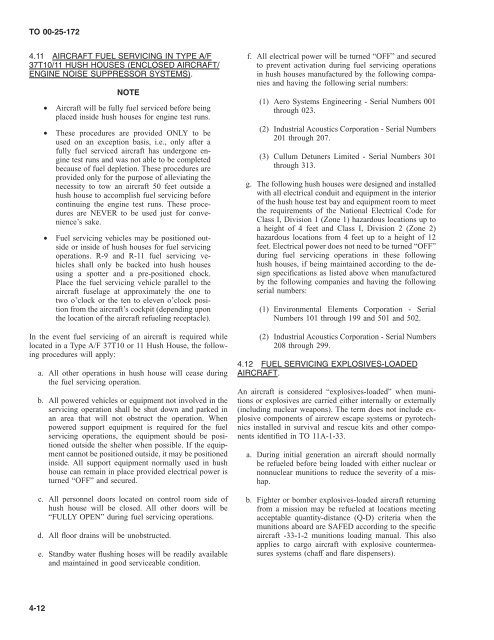TO 00-25-172 - Robins Air Force Base
TO 00-25-172 - Robins Air Force Base
TO 00-25-172 - Robins Air Force Base
You also want an ePaper? Increase the reach of your titles
YUMPU automatically turns print PDFs into web optimized ePapers that Google loves.
<strong>TO</strong> <strong>00</strong>-<strong>25</strong>-<strong>172</strong><br />
4.11 AIRCRAFT FUEL SERVICING IN TYPE A/F<br />
37T10/11 HUSH HOUSES (ENCLOSED AIRCRAFT/<br />
ENGINE NOISE SUPPRESSOR SYSTEMS).<br />
NOTE<br />
• <strong>Air</strong>craft will be fully fuel serviced before being<br />
placed inside hush houses for engine test runs.<br />
• These procedures are provided ONLY to be<br />
used on an exception basis, i.e., only after a<br />
fully fuel serviced aircraft has undergone engine<br />
test runs and was not able to be completed<br />
because of fuel depletion. These procedures are<br />
provided only for the purpose of alleviating the<br />
necessity to tow an aircraft 50 feet outside a<br />
hush house to accomplish fuel servicing before<br />
continuing the engine test runs. These procedures<br />
are NEVER to be used just for convenience’s<br />
sake.<br />
• Fuel servicing vehicles may be positioned outside<br />
or inside of hush houses for fuel servicing<br />
operations. R-9 and R-11 fuel servicing vehicles<br />
shall only be backed into hush houses<br />
using a spotter and a pre-positioned chock.<br />
Place the fuel servicing vehicle parallel to the<br />
aircraft fuselage at approximately the one to<br />
two o’clock or the ten to eleven o’clock position<br />
from the aircraft’s cockpit (depending upon<br />
the location of the aircraft refueling receptacle).<br />
In the event fuel servicing of an aircraft is required while<br />
located in a Type A/F 37T10 or 11 Hush House, the following<br />
procedures will apply:<br />
a. All other operations in hush house will cease during<br />
the fuel servicing operation.<br />
b. All powered vehicles or equipment not involved in the<br />
servicing operation shall be shut down and parked in<br />
an area that will not obstruct the operation. When<br />
powered support equipment is required for the fuel<br />
servicing operations, the equipment should be positioned<br />
outside the shelter when possible. If the equipment<br />
cannot be positioned outside, it may be positioned<br />
inside. All support equipment normally used in hush<br />
house can remain in place provided electrical power is<br />
turned “OFF” and secured.<br />
c. All personnel doors located on control room side of<br />
hush house will be closed. All other doors will be<br />
“FULLY OPEN” during fuel servicing operations.<br />
d. All floor drains will be unobstructed.<br />
e. Standby water flushing hoses will be readily available<br />
and maintained in good serviceable condition.<br />
f. All electrical power will be turned “OFF” and secured<br />
to prevent activation during fuel servicing operations<br />
in hush houses manufactured by the following companies<br />
and having the following serial numbers:<br />
(1) Aero Systems Engineering - Serial Numbers <strong>00</strong>1<br />
through 023.<br />
(2) Industrial Acoustics Corporation - Serial Numbers<br />
201 through 207.<br />
(3) Cullum Detuners Limited - Serial Numbers 301<br />
through 313.<br />
g. The following hush houses were designed and installed<br />
with all electrical conduit and equipment in the interior<br />
of the hush house test bay and equipment room to meet<br />
the requirements of the National Electrical Code for<br />
Class I, Division 1 (Zone 1) hazardous locations up to<br />
a height of 4 feet and Class I, Division 2 (Zone 2)<br />
hazardous locations from 4 feet up to a height of 12<br />
feet. Electrical power does not need to be turned “OFF”<br />
during fuel servicing operations in these following<br />
hush houses, if being maintained according to the design<br />
specifications as listed above when manufactured<br />
by the following companies and having the following<br />
serial numbers:<br />
(1) Environmental Elements Corporation - Serial<br />
Numbers 101 through 199 and 501 and 502.<br />
(2) Industrial Acoustics Corporation - Serial Numbers<br />
208 through 299.<br />
4.12 FUEL SERVICING EXPLOSIVES-LOADED<br />
AIRCRAFT.<br />
An aircraft is considered “explosives-loaded” when munitions<br />
or explosives are carried either internally or externally<br />
(including nuclear weapons). The term does not include explosive<br />
components of aircrew escape systems or pyrotechnics<br />
installed in survival and rescue kits and other components<br />
identified in <strong>TO</strong> 11A-1-33.<br />
a. During initial generation an aircraft should normally<br />
be refueled before being loaded with either nuclear or<br />
nonnuclear munitions to reduce the severity of a mishap.<br />
b. Fighter or bomber explosives-loaded aircraft returning<br />
from a mission may be refueled at locations meeting<br />
acceptable quantity-distance (Q-D) criteria when the<br />
munitions aboard are SAFED according to the specific<br />
aircraft -33-1-2 munitions loading manual. This also<br />
applies to cargo aircraft with explosive countermeasures<br />
systems (chaff and flare dispensers).<br />
4-12
















